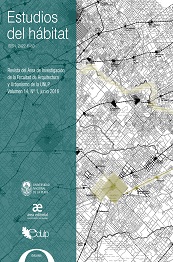DEL RASCACIELOS AL RASCASUELOS. La casbah japonesa de Rem Koolhaas
Palavras-chave:
Koolhaas, Rem, Mat-building, Vivienda colectivaResumo
Podemos decir que Rem Koolhaas, como el resto de arquitectos de la arquitectura contemporánea, bebe de las ideas que desarrollaron los arquitectos que reaccionaron a las propuestas de los Congresos Internacionales de Arquitectura Moderna (CIAM). Woods, junto a Candilis y Josic, desarrolló una nueva tipología de edificio al que él da el nombre de rasca-suelos, pero que conocemos por el término que le otorga Alison Smithson: el mat-building. Rem Koolhaas, en el edificio Nexus World, propone, según él, un edificio de viviendas que convine las viviendas patio de Mies y los edificios de la antigua Roma, que parecen un tapiz continuo donde las casas nunca llegan a ser objetos. En definitiva, un edificio alfombra. Koolhaas traslada la ciudad árabe a las ciudad nipona y aplica lo que ha aprendido con “Delirious New York”, introduciendo las características del rascacielos en su rasca-suelos, redefiniendo la tipología del mat-building.
Downloads
Métricas
Referências
Amoma, Koolhaas, R., &&& -Brown, Simon + Link, J. (2004) Content Colonia: Taschen.
Cortéz, J. A. (2006) “Delirio y más. I. Las lecciones del Rascacielos” El Croquis, OMA/Rem Koolhaas. 1996/2006, (131-132), pp. 8-31.
Drew, P. (1973) Tercera generación. Barcelona: Gustavo Gili SA.
El Croquis, OMA/Rem Koolhaas 1996/2006, (134-135), pp. 8-31.
Jurado del Premio Priztker (2000) Recuperado de:
http://www.pritzkerprize.com/2000/jury
Koolhaas, R. (1995) S,M,L,XL, The Monacelly Press “Triumph: Fukuoka housing is a triumph” ;”Should he project be as “ western as possible”? Is it just another export like a Van Gogh, a Mercedes a Vuitton bag? Or should it refl ect the fact that it exists in Japan?”. Traducción de la autora.
Koolhaas, R. (2004) Delirio de Nueva York, Barcelona: Gustavo Gili.
Koolhaas, R.; Zaera Polo, A. (1992) Encontrando libertades: Conversaciones con Rem Koolhaas. El Koolhaas, R.; Zaera Polo, A. (1996) El día después: una conversación con Rem Koolhaas. El Croquis, OMA/Rem Koolhaas 1992/1996, (79) pp. 8-37.
Krunic, D. (2012) The “Groundscraper”: Candilis-Josic-Woods and the free University building in Berlin, 1963-1973. ARRIS, journal of the Southeast Chapter,Society of Architectural Historians. Volumen 23, pp. 30-49. “In skyscraper type building disciplines tend to be segregated, the relationship from one fl oor to another is tenuous, almost fortuitous, passing through the space, machine, lift. In a ground-scraper organization greatest possibilities of community and exchange are present without
neces-sarily sacrifi cing any tranquility” Traducción de la autora.
Smithson, A.(1974). How to recognize and read mat building: Mainstream architecture as it has devel oped towards the mat building. A.D. Septiembre 1974 pp. 573-590.
Smithson, A. (1991) Team 10 meetings edited by Alison
Smithson. Rizzoly International Publication.Team 10 1953-81. On search of a Utopia of the present.(2006) Bélgica: NAi Publishers, Rotterdam.
Woods, S. (1961) Web. Le Carre bleu 3-1961. “L’urbanisme est l’architecture font partie d’un meme processus. L’architecture imprimer une forme aux activés humaines : l’urbanisme ordonne les rapports entre ces diverses activités. L’urbanisme établit le milieu dans lequel l’architecture naît. […] Il doit déceler, explorer et rendre clairs les rapports entre les activités humaines. Il doit associer ces activités de telle façon que la totalité de la vie dans un complexe urbain devienne plus riche que la somme des parties composantes”. Traducción de la autora.
Zunthor, (2006). Atmosfera. Barcelona: Gustavo Gilli
Downloads
Publicado
Como Citar
Edição
Seção
Licença
Acorde a estos términos, el material se puede compartir (copiar y redistribuir en cualquier medio o formato) y adaptar (remezclar, transformar y crear a partir del material otra obra), siempre que a) se cite la autoría y la fuente original de su publicación (revista y URL de la obra), b) no se use para fines comerciales y c) se mantengan los mismos términos de la licencia.








.jpg)

















